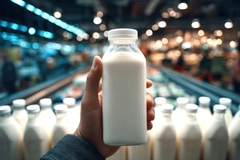UNESDA: EU soft drinks industry pledges full circularity by 2030 and reuse expansion

25 Feb 2021 --- UNESDA, the association representing the European soft drinks industry, is pledging to make EU beverage packaging fully circular by 2030.
UNESDA members include corporations such as Coca-Cola, PepsiCo and Danone. All members will be involved in reaching the association’s new targets.
Laid out in UNESDA’s “Circular Packaging Vision 2030,” the targets include achieving 100 percent recyclable packaging and 50 percent recycled content in PET bottles by 2025.
The commitment also envisions making PET bottles from 100 percent recycled or renewable PET – where technically and economically feasible – by 2030.
Furthermore, more than 90 percent of packaging will be collected, and an expansion of reuse and refill schemes will continue throughout the EU.
These targets embody UNESDA’s “Collect, Recycle, Reduce and Reuse” method for combating packaging waste throughout the continent.
Collection scheme hurdles
Speaking to PackagingInsights, UNESDA director-general Nicholas Hodac, details the challenges Europe’s beverage industry now faces in reaching these ambitious targets and how they will be overcome.
 UNESDA has nine corporate members from the global beverage industry working towards its circularity goals.“The challenge for collection will be having in place well-designed waste collection schemes such as deposit return schemes (DRS),” he says.
UNESDA has nine corporate members from the global beverage industry working towards its circularity goals.“The challenge for collection will be having in place well-designed waste collection schemes such as deposit return schemes (DRS),” he says.
“They need to be efficient in incentivizing consumers to return their glass, PET bottles and cans so we get back the content we need for recycling.”
The beverage industry is now under increasing competition from other sectors and industries looking for recycled content to use in products as part of their sustainability commitments.
UNESDA is hoping to get support from the European Commission to make sure the beverage industry gets back the material it puts into the recycling system, says Hodac.
“It would be a waste if the food-grade quality recycled PET (rPET) we need is finding its way into car bumpers.”
The refill challenge  Germany has the highest collection rate of PET in the EU (95%).The other central challenge UNESDA foresees is driving the use of refillable packaging.
Germany has the highest collection rate of PET in the EU (95%).The other central challenge UNESDA foresees is driving the use of refillable packaging.
“We are determined to transition toward refillable, and it is clearly something we see the younger generation as wanting. However, the market around Europe is currently not mature, and it remains very much limited to glass bottles in bars.”
“There is a steep learning curve here for all of us, and we are studying the best environmental and socio-economic pathways to increasing refillable models. Innovation and consumer acceptability will be key here – as in many areas of the circular economy,” continues Hodac.
Calling for government intervention
Achieving UNESDA’s targets will require committed political cooperation, adds Hodac – something the association hopes will come in through the Packaging and Packaging Waste Directive, currently under revision.
“In particular, we need a long-term perspective and legal certainty within the EU single market so industry can make investments in infrastructure and production to make this a reality.”
“We also need a well-functioning secondary raw materials market. Increased investment in waste management and recycling infrastructure would also be important, as will an EU framework for enabling innovative recycling technologies,” he asserts.
The EU will need to set minimum requirements for DRS and clear definitions of recyclability. Doing what is needed, says Hodac, is likely to run into hundreds of millions of euros.
Will the EU Plastics Tax work?
Hodac is meanwhile skeptical of the EU Plastics Tax, which came into effect this year.
“I’m not sure that taxes will deliver more collection and recycling and more access to recycled materials. An arbitrary tax on all plastic packaging is too simplistic.”
“If taxes are introduced in Europe, then the revenue should be earmarked for investments in circularity and should incentivize consumers and producers to make behavioral changes.”
“It seems a pity the focus of taxation has been to ban things and stop them when it could be used to incentivize circularity.”.jpeg) The EU Plastics Tax is a proposed levy on non-recycled plastics for member states.
The EU Plastics Tax is a proposed levy on non-recycled plastics for member states.
PET carries plastics recycling
The rates of collection for PET bottles in Europe is already very high. UNESDA research demonstrates countries like Germany and Denmark successfully collect over 90 percent of used PET beverages.
However, in other countries like Greece, collection rates are as low as 24 percent.
“It’s not a question of market maturity. It's more a question of mindset and willingness, and we need to share best practices across markets to encourage those lagging behind to catch up,” says Hodac.
Moreover, other material markets like polyethylene (PE) and polypropylene (PP) can learn a lot from the PET market’s success, he highlights.
“Our plastic bottles are already more than 90 percent recyclable, and the soft drinks industry has been instrumental in setting up and running many of the collection schemes across Europe.”
“So, that needs to be in place for other materials – not just plastics – and then end-users need to understand what they need to do and to be motivated to do it.”
In notable examples of rPET uptake, FrieslandCampina switched to fully recycled bottles for its Fristi, Chocomel, Yazoo and Pöttyös dairy beverages in February.
Meanwhile, PepsiCo is aiming to eliminate all virgin plastic from its Pepsi brand beverage bottles sold in nine EU markets by 2022.
By Louis Gore-Langton











